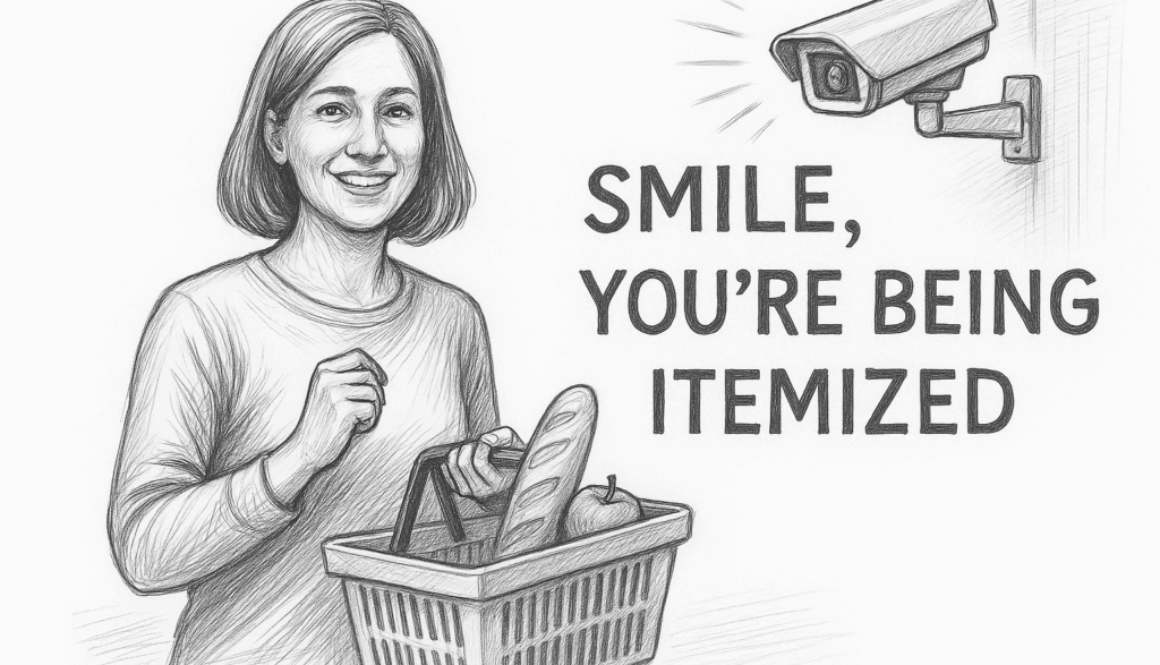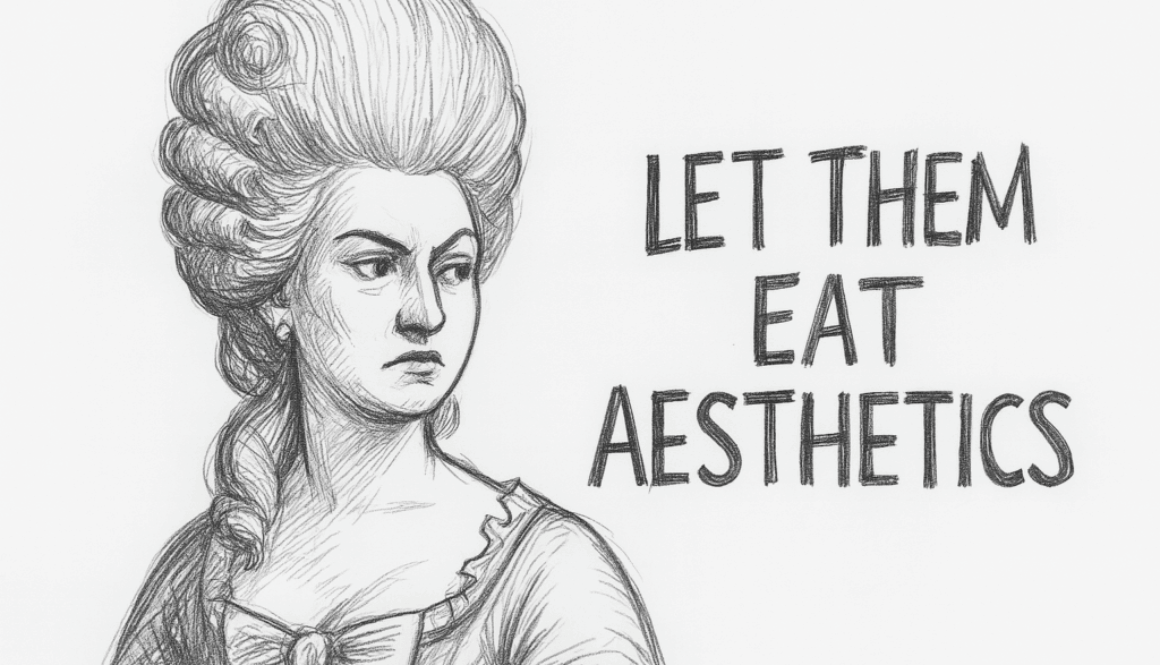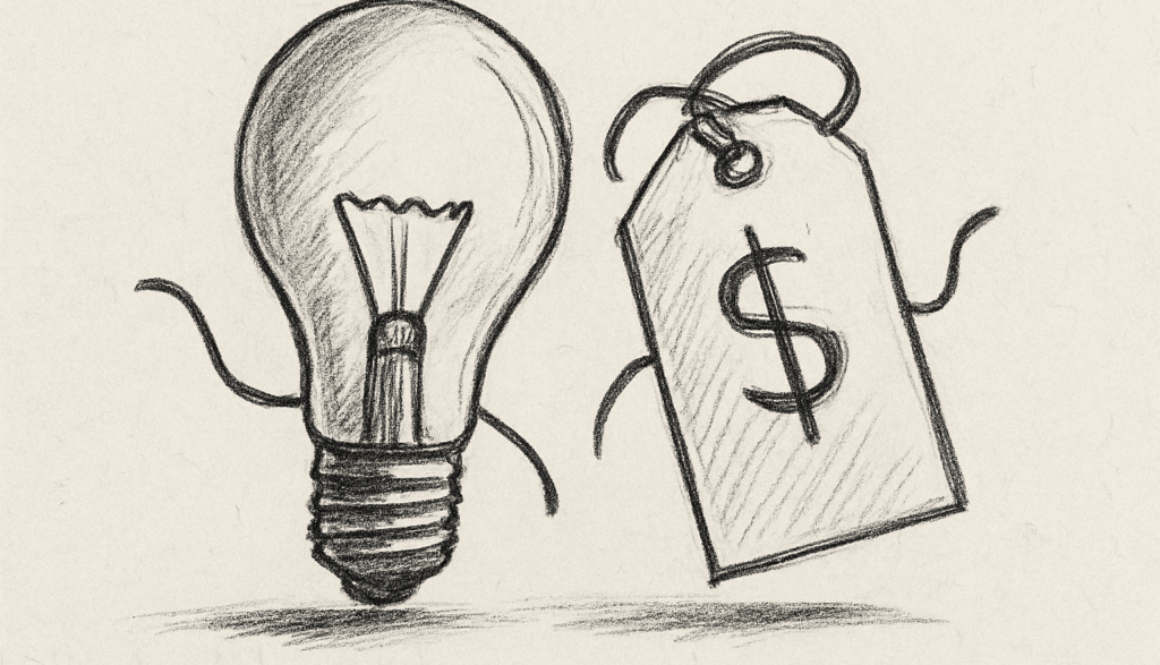
Sales


Smile, You’re Being Itemized
When your groceries come with surveillance baked in.
Hey everyday shoppers—
I walked into a Rewein Germany expecting a “fast lane” checkout: the kind where you scan your own groceries, beep by beep, cashier-for-a-minute.
Instead, something different happened. I set my basket on a platform—and the total appeared instantly.
Even the loose bread rolls were counted correctly.
Magic? No. Cameras. Everywhere.
At first, it felt like wonder. Seconds saved. No queues. No mistakes. But walking out, I realized what I had really bought: a glimpse of our future, where every product lifted off a shelf is tracked, logged, priced, and tied to a customer ID.
From retail magic to surveillance logic
This isn’t futuristic.
It’s Amazon Go logic exported: ceiling cameras, weight sensors, AI vision, and real-time databases translating human gestures into transactions. What looks like convenience is in fact industrial-grade surveillance tech disguised as customer service.
Amazon reportedly invested over $3 billionin its cashierless Go stores. By 2023, it had to scale back expansion plans: operating costs were too high, and the technology wasn’t foolproof.
Rewe, Aldi, Tesco, and Carrefour are now piloting similar systems across Europe, often in partnership with startups like Trigo and AiFi. Each installation can cost hundreds of thousands of euros per store.
Supermarkets sell it as frictionless.
But frictionless isn’t neutral. Friction is often where privacy lives.
When you no longer scan your bread, the system is scanning you.

Here’s the paradox: the smoother the surface, the more complex the machinery beneath.
These systems require:
- Constant video tracking of every shopper
- AI models trained to recognize thousands of products in any orientation
- Behavioral logs to prevent theft or error
- Data fusion across payment, loyalty cards, and cameras
And all that complexity exists for what? Saving two minutes at checkout. The exchange rate: privacy for convenience.
Who really benefits?
The supermarket reduces labor costs.
Brands get granular data on shopping behavior: what you touched, what you put back, how long you lingered in the aisle.
Tech vendors sell multi-million euro systems. And the shopper? You get a faster exit—and a data trail thicker than your receipt.
Convenience is the pitch. But surveillance is the product.

Other cases: lessons learned
- Amazon Go (US/UK): hyped as the future of retail, but by 2022 reports showed profitability struggles. Some stores closed; the tech was quietly rebranded as “Just Walk Out” for third-party retailers.
- Tesco GetGo (UK): partnered with Trigo, using AI to monitor shelves and shoppers. Critics flagged GDPR issues around constant video surveillance.
- Carrefour Flash (France): introduced “10-second shopping trips,” with over 60 cameras in a single small store. Consumer groups raised alarms over data retention.
- Aldi Nord (Germany): pilot stores in Utrecht and London tested fully automated checkout-free systems—backed by AI startups aiming to scale Europe-wide.
The pattern is clear: huge upfront investment, uncertain ROI, and growing consumer unease.
The real question
This isn’t about supermarkets.
It’s about boundaries. Are we willing to outsource autonomy to avoid a checkout line? Are we prepared to normalize being scanned, tracked, and tagged as the “cost” of speed?
The technology is already here.
The only missing ingredient is resistance. Because frictionless living may feel smooth—until you realize it’s your freedom that’s being sanded down.
Until next time, stay alert.
Alex
At Kredo Marketing, we build growth strategies that respect privacy and transparency. Because trust is worth more than speed.

Let Them Eat Aesthetics
Hey beauty skeptics—
Let’s kill a sacred cow: the idea that if something costs more, it must be more beautiful.
We’re not just talking luxury handbags or designer chairs.
This illusion creeps into how we see, desire, and validate everything around us.
And yes, there’s science to prove it.
Price messes with your brain
In 2008, Stanford and Caltech ran a sneaky little wine experiment.
People drank the same exact wine twice—once with a $10 label, once with a $90 label. Want to guess which one they raved about?
The expensive one. Their brains even lit up more in the pleasure zone (orbitofrontal cortex, if you’re into that kind of thing).
Same wine. Different story. Because the price wrote the story.
It doesn’t stop at wine. In 2020, researchers in Bologna gave people identical paintings with different price tags. The expensive ones? “More moving,” “more beautiful,” “deeper meaning.” Even art students fell for it.
Turns out your aesthetic judgment might just be a receipt in disguise.
How luxury brands trick your eyes
Luxury isn’t about better stuff. It’s about better theater.
Monochrome branding. Overexposed photography. Cryptic slogans. A logo so minimal it might not even exist. All of it whispers: “We’re expensive, therefore important.”
Sociologist Pierre Bourdieu called this symbolic violence. Translation: rich people make the rules of taste, and everyone else plays along.
And it works. A 2021 McKinsey report found that 70% of Gen Z luxury buyers picked “brand legacy and narrative” over actual product quality.
You’re not buying shoes. You’re buying a story where you’re the protagonist—and your shoes prove it.

Real beauty, small price
Some of the most iconic designs ever? Dirt cheap. And proudly so.
- Bic Cristal pen: Less than a euro. Transparent barrel, perfectly balanced, and a design so good it’s been copied endlessly—but never bettered. Even MoMA said yes.
- Fiat Panda (1980): Designed by Giugiaro as a tool, not a toy. Squared off, no frills, no fantasies. And yet, oddly poetic.
- Casio F-91W: A $20 watch that outlived fashion trends, batteries, and even surveillance fears. Functional, loyal, and iconic without trying.
- IKEA Billy: The democratic shelf. It doesn’t scream design—because it’s too busy serving it. And it’s probably in every city on Earth.
These objects didn’t ask to be beautiful. They became beautiful by being useful, honest, and real. No champagne-soaked launch parties. No limited editions. Just clever thinking, made accessible.
Why we still fall for price = beauty
Because we hate buyer’s remorse.
You drop €2,000 on something? You better love it. Even if it looks like a beige fungus. That’s post-purchase rationalization at work. Your brain edits the narrative to protect your ego.
And in a world full of design you don’t understand, price becomes your compass. It tells you what to like. What to envy. What to post.
But just because something is expensive doesn’t mean it’s beautiful.
It might just mean you’re scared to question it.

If luxury wants to survive the next generation of consumers, it has to grow up.
That means dropping the smoke and mirrors: no more false scarcity, inflated markups, or storytelling that hides mediocre craftsmanship behind heritage cosplay.
Ethical marketing isn’t a buzzword—it’s a correction.
It means pricing things based on real value: quality of materials, durability, originality of design. It means being transparent about production, not romanticizing sweatshops through sepia filters.
What would that market look like?
One where luxury isn’t about exclusion, but excellence. Where a beautiful object earns its price tag not through aura, but through intent. Where desirability comes from design, not deception.
Luxury can still be aspirational.
But let’s stop pretending mystery is a substitute for meaning.
Stop outsourcing your taste
Here’s a trick: next time you see a €12,000 chair in a showroom, imagine it at a flea market with a handwritten tag: “€70, negotiable.”
Would you still stop and stare?
Would you still call it art?
Because real beauty isn’t fragile.
It doesn’t need context. It doesn’t need a TED Talk or a celebrity endorsement. It just is.
And the moment you stop confusing cost with quality, you start seeing clearly.
Until next time, stay sharp.
Alex
At Kredo, we design brands that earn attention—not just price tags. If you’re building something that matters, we should talk.

Do Products Really Sell Themselves?
Hey demand chasers—
We’ve all heard it. “That product sells itself.” It’s the ultimate compliment—part envy, part resignation. But is it true?
Do some products really defy gravity and move on their own, without the push and pull of marketing? Or are we just blind to the invisible hands doing the selling?
Let’s break the myth apart. And maybe burn it a little.
The Illusion of the Self-Selling Product
There’s a seductive fantasy in business: if something is so good, it doesn’t need marketing.
Think of ChatGPT in late 2022. Ferrari. iPhone. The Birkin bag. Taylor Swift tickets. They all seem to flow through the market by some mysterious inertia. But that’s not absence of marketing. That’s marketing so deeply embedded, so culturally entrenched, that we no longer recognize it as such.
Ferrari doesn’t “sell.” It withholds. No test drives. No discounts. No influencer collabs. It’s scarcity turned into prestige. Every PR release is a masterclass in reverse psychology.
The Birkin bag has zero advertising spend. Yet has a waiting list, resale market, and entire YouTube channels dissecting “how to get one.” It’s the product equivalent of a religious artifact.
Taylor Swift? A billion-dollar tour machine powered by social currency, layered storytelling, Easter eggs, fan communities, media manipulation and a personal brand curated with surgical precision.
None of these are self-selling. They’re just so well-marketed they feel organic.

When Demand Exceeds Supply, Marketing Changes Clothes
Marketing isn’t always persuasion. Sometimes it’s framing. Sometimes it’s restraint.
In economics, when demand consistently exceeds supply, the job of marketing shifts. It’s no longer about pushing product.
It’s about managing desire.
This is what happened with Nintendo’s Wii, where artificial scarcity led to a 50% jump in media coverage and secondhand prices skyrocketing. Or with Glossier, where user-generated content, exclusivity drops, and minimalist branding made fans feel like insiders.
These strategies aren’t passive. They’re calculated. And they work because they understand that human psychology wants what it thinks it can’t have.
The Myth Is Dangerous (Especially for Startups)
Believing that great products sell themselves is a dangerous bias. It leads founders to underinvest in marketing, delay go-to-market planning, or ignore feedback loops.
In a 2023 survey by First Round Capital, 79% of failed startup founders cited “poor marketing execution”as a core reason for collapse.
Not product. Not funding. Marketing.
Stripe had a better developer experience. But it also built a legendary blog, launched on Hacker News, did partnerships with Y Combinator, and crafted elegant documentation.
Airbnb had photos. Craigslist didn’t. And they made sure everyone noticed.

If It Sells Itself, It’s Because Someone Worked for That
If a product seems to sell itself, it’s likely because:
- Someone shaped the narrative early.
- Someone built a community.
- Someone invested in design.
- Someone obsessed over product-market fit.
- Someone whispered in the right ears.
You just didn’t see it.
The “self-selling” myth is often just post-rationalized success. A product that looks effortless is usually the result of effort so well-deployed you missed it.
So… Does It Exist?
The honest answer? Rarely.
Some products catch a viral wave—timing, network effects, and a bit of luck. But even then, luck is just a name we give to unseen preparation.
Marketing isn’t just ads and copy. It’s product design. It’s timing. It’s distribution. It’s how you’re talked about when you’re not in the room.
So next time someone says, “This sells itself,” smile. And ask them: “Who made it look that way?”
Until next time, stay skeptical.
Alex
f your product’s great but no one knows it, you don’t need better luck. You need better marketing. At Kredo, we help brands design the demand they deserve.
Let’s make your product actually sell itself—by design.

Metrics as Myth: Why We Worship KPIs We Don’t Understand
Hey number chasers—
I once sat in a strategy meeting where a team leader proudly presented a dashboard glowing with green arrows.
CTR up 30%.
Engagement rate up 25%.
Bounce rate down.
The room buzzed with approval. But one quiet voice at the back asked: “What happened to revenue?”The answer? Flat.
Customer churn? Up 7%. Silence followed. The team had fallen in love with numbers that made them look good — while the business quietly eroded.
We weren’t reporting insights. We were performing a ritual.
The seduction of the green arrow
Marketing didn’t start with dashboards. It started with people — stories, trust, connection. Metrics were supposed to help us measure these things. Instead, they became our gods. We chant CTR, CPA, DAU, LTV as if they’re magic.
But few pause to ask: Do I really understand what’s behind this number? What it reflects? What it hides?
According to a 2023 Gartner report, 68% of CMOs admit they report metrics they don’t fully trust or understand. A 2022 Forrester study found 54% of marketing dashboards are stuffed with vanity metrics disconnected from business outcomes. We do it because it’s easy. Because it calms stakeholders. Because it tells a comforting story — even when it’s fiction.
And here’s the brutal truth: sometimes the best-performing campaigns are the ones you can’t measure. Because they change culture, not clicks.
The most valuable ideas often resist quantification — but we ignore them, because they don’t fit the slide deck.

When metrics become myths: the real cost of chasing ghosts
🔹 The Facebook video bubble (2015-2018): Seduced by video view counts (later revealed to be overstated by up to 80%), media companies laid off thousands after betting billions on a metric that was a mirage.
🔹 The NPS delusion: Airlines boasting high NPS while ranking bottom in J.D. Power satisfaction surveys. NPS can be gamed; loyalty can’t.
🔹 Startup vanity growth: App developers proudly report millions of downloads — but fewer than 10% of users return after the first use (App Annie, 2023).
🔹 iOS15 open rate illusion: Teams cheered stable open rates, unaware Apple’s privacy updates had broken the metric’s meaning.
🔹 The rebrand trap: A major CPG brand spent millions on a rebrand that spiked awareness metrics by 200% — but drove a 15% sales decline as loyal customers no longer recognized the product.
Dashboard dopamine and budget black holes
Dashboards reward us like slot machines.
Green arrows and rising lines give instant gratification. But impact takes deeper digging.
MIT Sloan (2022) found companies chasing vanity metrics were 2.3x more likely to miss revenue targets. A HubSpot report estimated that up to 27% of marketing spend in mid-sized firms is wasted on efforts optimized for the wrong KPIs.
How much time, energy, and money are we burning worshipping the wrong numbers? How many great ideas are left unexplored because they don’t fit on a dashboard?

What we should measure — but don’t
✅ Cohort retention: Who stays beyond the first impression?
✅ Net revenue retention: Are we growing value, not just headcount?
✅ Behavior change: Did we shift habits, not just clicks?
✅ Customer advocacy: Who champions us unprompted?
✅ True ROI: Does each marketing dollar create durable value?
Patagonia tracks product returns as a proxy for quality. Signal measures success by active, engaged users — not downloads. Basecamp focuses on customer longevity, not lead gen volume.
A provocation for your next meeting
Next time you see a dashboard, try this:
👉 Remove one vanity metric. Watch what happens to the discussion.
👉 Ask: What’s behind this number? What human behavior does it represent?
👉 Challenge a metric that looks “too good.” Dig for what it’s hiding.
Because the most dangerous metric is the one that rises while your business quietly dies.
Until next time, stay skeptical.
Alex
At Kredo Marketing, we help brands cut through vanity metrics and build strategies grounded in what truly drives impact. Want to focus on value, not noise? Let’s talk.

When the Answer Comes with a Price Tag >> Google’s Plan to Hijack Chatbots with Ads
Hey ad resisters — this one’s going to sting.
Google is now testing ads injected directly into AI chatbot responses.
You ask a question. You get an answer.
But that answer might be paid for. Invisible bias wrapped in machine efficiency. If you’re not alarmed yet, you should be.
From Disruption to Domination: A Brief History of Google’s Advertising Empire
Back in 2000, Google introduced a revolutionary model: AdWords.
Unlike banner ads that screamed for attention, these were text-based, relevance-driven, and tied to search queries.
It was brilliant. Subtle. Useful.
The user got what they needed, and advertisers paid to be seen. Google made billions.
Then came AdSense (2003), allowing publishers to monetize their sites with Google’s targeting power. Next, Google bought DoubleClick in 2007, expanding its grip on display advertising. By 2010, Google wasn’t just a search engine — it was the operating system of the internet economy.
Then came YouTube. Then mobile. Then the integration of ads into Gmail, Maps, the Play Store, Chrome. And now, in 2025, chatbots.
What began as a clever monetization strategy has evolved into a system of total dominance.
In 2023, Google controlled over 39% of global digital ad spending.
That’s not competition. That’s empire.
Why Is Google Doing This?
The answer is simple and devastating: to protect its cash cow.
Search is evolving. Users are spending less time on traditional query pages and more time inside conversational interfaces — like ChatGPT, Gemini, Claude. These platforms threaten Google’s ad revenue because they sidestep the classic search-ad-click loop.
So what does Google do? It brings the ads inside the conversation. Embeds them in the AI’s voice. Blurs the line between organic and paid until it no longer exists.
It’s not just a business move.
It’s a cultural betrayal.
Is It Ethical?
No. It’s not.
Advertising in itself isn’t evil. But embedding ads within tools that users perceive as neutral, objective, or informative — without clear disclosure — is manipulative.
Chatbots don’t just give you data. They shape how you think. How you decide. If commercial interests are baked into the machine, then your worldview is being auctioned in real time.
This is not about relevant suggestions.
It’s about epistemological control.
And the scariest part? You might not even realize it’s happening.
Where Should We Draw the Line?
The internet has never been free of commerce. But we need red lines:
- Full transparency: Paid content in AI must be clearly labeled.
- User control: Opt-out options must be standard, not hidden.
- No ads in critical queries: Health, legal, financial, political — these areas should be sacred.
- No personalization without permission: Targeted ads based on private chats? That’s surveillance, not service.
If AI is the next interface of knowledge, we must defend it from becoming a billboard.
What Can Be Done?
This isn’t just a fight for lawmakers. It’s a fight for all of us.
- Push for regulation: Demand AI-specific ad legislation.
- Support open-source alternatives: Like Mozilla’s projects or non-profit LLMs.
- Call it out: Public pressure works. Remember when WhatsApp tried to share data with Facebook?
- Use blockers: AI interfaces must be audited and filtered, just like browsers.
And maybe most importantly:
Talk about it. Share the danger. Expose the subtle creep. Make the manipulation visible.
Wake Up Before the Chat Sells You Out
This is not just another product update. It’s a philosophical pivot. From helping you navigate the world to selling you a version of it tailored to someone else’s profit.
When knowledge becomes an ad space, the truth itself becomes negotiable.
So next time you ask a chatbot something important, remember:
Is this answer here to help me — or to sell me?
Until next time, stay alert.
Alex
At Kredo Marketing, we believe transparency builds trust.
💬 Let’s create human-first strategies that respect users, not exploit them.

The Paradox of AI-Powered Marketing: Why Being Smart Hurts Sales
Hey curious minds—ready for a truth bomb that might short-circuit your strategy?
We’ve built AIs that can predict behavior, generate copy, analyze heatmaps, and design creative assets in seconds.
AI knows when your audience is most active, what headlines convert, what colors trigger emotion, and even what words to avoid.
It can track eye movements, suggest emotional arcs, and simulate empathy with remarkable precision.
And yet—the best campaigns aren’t always the smartest ones.
In fact, sometimes, the more “optimized” your marketing is… the less it connects.
The more frictionless the funnel, the more it feels like a trap.
Let’s explore why that’s happening—and why it matters more than ever.
The AI Promise: Personalization, Scale, and Precision
AI tools were sold to marketers like a magic wand:
- Endless A/B testing at lightning speed
- Predictive segmentation so sharp it feels like mind reading
- Generative content that adapts to every persona and channel
- UX optimization that minimizes bounce and maximizes clicks
And sure, it works. CTRs go up. Bounce rates go down. Lead scores improve.
But so does the sameness. The predictability. The polish that starts to feel sterile.
When every message is perfectly personalized, perfectly timed, and perfectly predictable, it begins to feel… robotic.
Even creepy.
You don’t feel seen.
You feel processed.
Consumers aren’t dumb—they know when they’re being handled.
Why We Crave Imperfection
Here’s the paradox: People want to feel understood, not dissected. They want connection, not calculation. They want the nuance that comes with real human awkwardness.
That ad you loved?
Maybe it had a typo. Maybe it didn’t follow brand guidelines. Maybe it felt spontaneous, off-script, slightly chaotic.
It didn’t fit the algorithm. But it made you feel something.
That weird product video with the shaky camera and unpolished sound? It made you laugh. Or cry. Or remember it 3 days later because it wasn’t perfect.
AI can simulate emotion. But it doesn’t know what it meansto feel awkward, uncertain, messy—like we do.
And that’s often where the sale happens. Not at the peak of clarity, but in the fog of authenticity.

The Danger of Data-Driven Conformity
When every brand uses the same AI models trained on the same datasets optimizing for the same KPIs… what do we get?
A sea of polished, optimized mediocrity.
Every landing page feels like it was designed by the same person. Every Instagram ad looks like it came out of the same content machine. Every chatbot sounds like a cheerful hostage.
In trying to stand out, brands are actually blending in.
Optimization becomes homogenization.
Creativity becomes compliance.
We’ve replaced originality with A/B-tested monotony. And it shows.
Look at the rise of low-fi, chaotic, TikTok-style videos that blow up precisely because they break the rules.
Or brands like Liquid Death, Duolingo, and Glossier that embrace weirdness, contradiction, and irreverence—not because it’s efficient, but because it’s memorable.
Think of RyanAir’s bizarre TikTok presence, or the success of Wendy’s Twitter roasts.
These aren’t accidents.
They’re symptoms of a cultural appetite for unfiltered noise in a world of sterile optimization.
Real human resonance is unpredictable.
Unscalable.
Illogical.
And that’s why it works.
Why Being Weird Wins (and Being Perfect Doesn’t)
We remember what surprises us. We trust what feels like a real person. That means awkward pauses, accidental jokes, unexpected honesty.
AI can’t do unpredictability by definition.
It’s trained to play it safe. It learns from the past and optimizes toward consensus. But consensus doesn’t lead—it follows.
The brands leading today aren’t afraid to get weird. They’re not afraid to break tone, bend guidelines, or speak in a voice that doesn’t feel rehearsed.
And guess what? Customers love them for it.
In the end..
AI should be your co-pilot—not your identity.
Let it run your backend.
Let it test your subject lines. Let it help you write smarter, build workflows, and scale outreach.
But when it’s time to connect with other humans?
Step away from the model.
Write something weird. Say something raw. Show something real. Share the post that might flop—but might also go viral because it has soul.
Because in a world where machines can say everything—your imperfections might be the only thing that sounds like you.
Until next time, stay human.
Alex
🔥 Want AI that enhances—not erases—your voice?
At Kredo Marketing, we blend intelligent automation with unapologetic humanity.
💬 Let’s keep your brand weird, real, and unforgettable.